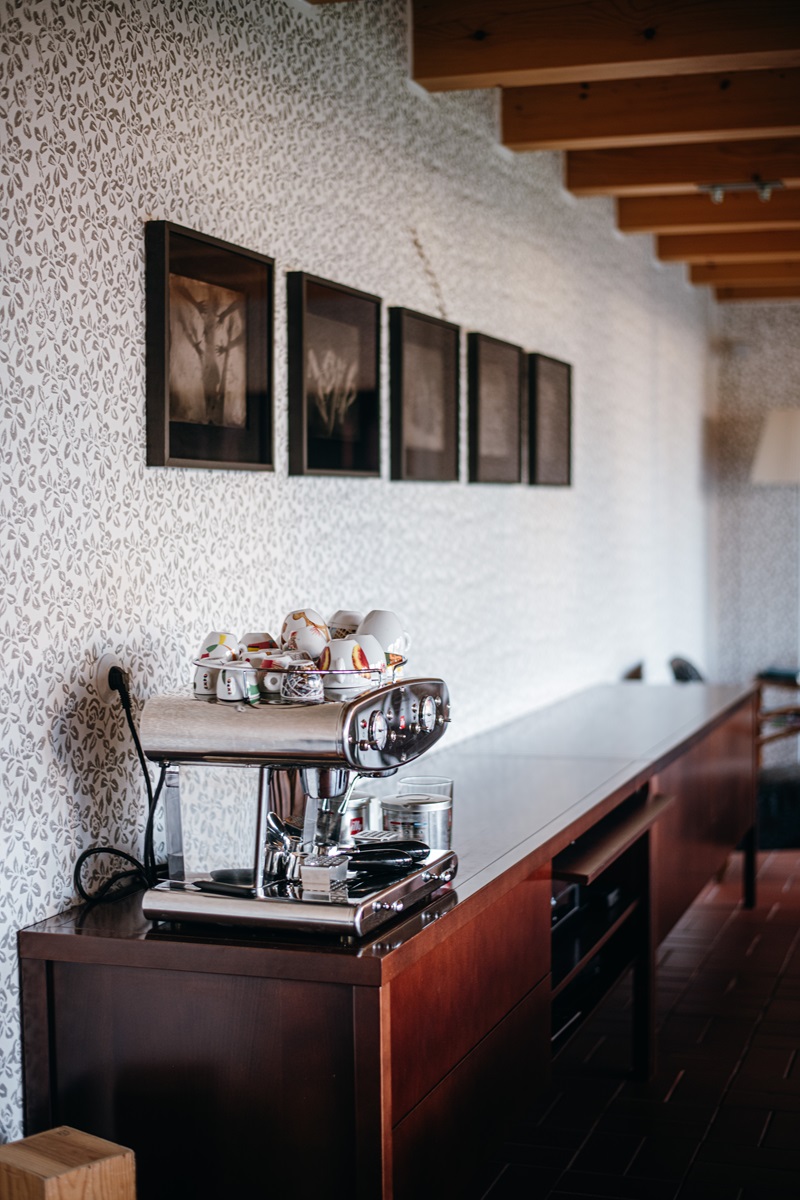MLÝN HRUŠKY A VILLA HRUŠKY
15. listopadu 2024
Tentokrát mám pro vás tip na krásné místo na jižní Moravě, které jsem až dosud neznala*. Navštívila jsem jej v rámci focení jednoho projektu, ale zamilovala jsem si jej na první pohled. Velký otevřený prostor, architektura, detaily a příjemný personál.
MLÝN HRUŠKY A VILLA HRUŠKY
Restaurace Mlýn Hrušky a penzion Villa Hrušky se nachází v obci Hrušky nedaleko Břeclavi. Oba objekty spolu sousedí a spolu s rozsáhlým prostranstvím terasy a zahrady s posezením a bazénem poskytují skvělé zázemí.
Budova restaurace (Mlýn) byla, jak už sám název napovídá, válcovým mlýnem, který byl založený ve 30. letech 20. století. Bohužel po válce došlo k jeho znárodnění a stavba postupně chátrala v ruinu. Tu získala rodina původních majitelů, kteří své rodinné dědictví dokázali vkusně zrekonstruovat a proměnit v toto kouzelné místo. Za proměnou mlýna stojí renomované architektonické studio Pelčák a partner.
Mlýn Hrušky nabízí kromě skvělé kuchyně i prostor pro ochutnávky vín. Villa Hrušky pak příjemné ubytování v penzionu s moderním a rustikálním nádechem.
Během focení jsme měli štěstí na krásné světlo a zapadající podzimní slunce dodalo otevřenému cihlovému prostoru neskutečnou atmosféru. Nakoukněte se mnou nejen do restaurace, ale také do části penzionu a zahrady a nechte se inspirovat na výlet nebo ochutnávku.
* Sklenice na víno a pití, barevné džbány pochází ze sklárny Květná 1794
(* Nejedná se o placenou spolupráci, všechny názory jsou mé vlastní. Základní informace o Mlýně a penzionu byly převzaty z oficiálních sítí výše jmenovaných)
MILL HRUŠKY AND VILLA HRUŠKY
This time I have an exceptional tip for you about an amazing place in southern Moravia that I didn't know until now*. I visited it as part of a photo shoot for a project, but I fell in love with it at first sight. Large open space, architecture, details, and friendly staff.
The Mill and Villa Hrušky are located in the village of Hrušky near Břeclav (Czech Republic). Both buildings are adjacent to one location and, together with the large area of terrace and garden with sitting area and swimming pool, provide a great background.
The restaurant building (Mill) was, as the name itself suggests, a roller mill that was founded in the 1930s. Unfortunately, after the war it was nationalized, and the building gradually fell into ruin. It was acquired by the family of the original owners, who were able to sensitively reconstruct their family heritage and turn it into this magical place. Renowned architectural studio Pelčák and partner is behind the transformation of the mill. Mill Hrušky offers, in addition to excellent cuisine, a space for wine tasting. Villa Hrušky offers pleasant accommodation in a guesthouse with a modern and rustic touch.
We were lucky to have beautiful light during the photo shoot, and the setting autumn sun gave the open brick space an incredible atmosphere. Look with me not only in the restaurant, but also in part of the guesthouse and the garden and let yourself be inspired for a trip or a tasting.
* Wine and drinking glasses, colored jugs come from the Květná 1794 glassworks
(* This is not a paid collaboration, all opinions are my own. Basic information about the Mill and the guesthouse was taken from the official networks of the above mentioned)
OŘECHOVÉ ROHLÍČKY
11. listopadu 2024
Zřejmě nikdy nepeču ořechové rohlíčky tak často jako na podzim a v zimě. Mívali jsme vždy spoustu ořechů u babičky na zahradě a tak je bylo nutné zpracovat. Něco se nechalo na Vánoce do cukroví, ale ze zbytku jsme pekli buchty. Podzimní období mám tak spjaté s ořechovými buchtami a koláči.
Tyto ořechové rohlíčky patří k našim oblíbeným. Jsou bez kynutí, po upečení křupavé. A stejně jako jsou rychle upečené, tak stejně rychle zmizí. Někdy nestačí ani pořádně vychladnout.
Kromě klasických ořechů můžete použít pekanové nebo lískové ořechy, ale také tvaroh nebo povidla. Těsto je chuťově neutrální, takže budou skvělé s každou náplní.
OŘECHOVÉ ROHLÍČKY
INGREDIENCE
Cca 20–24 ks (podle velikosti)
TĚSTO
400 g hladké mouky
150 g zakysané smetany
250 g másla pokojové teploty
špetka soli
NÁPLŇ
300 g mletých ořechů (vlašských, pekanových, lískových podle chuti)
130 g moučkového cukru
4 lžíce mléka
2 lžíce rumu
1 vejce
POSTUP
1. Nejprve zpracujeme těsto – smícháme hladkou mouku, zakysanou smetanu, máslo pokojové teploty a špetku soli. Vypracujeme hladké těsto, které vytvarujeme do bochánku, zabalíme do potravinářské fólie a necháme 1-2 hodiny odpočívat v lednici.
2. Mezitím si připravíme ořechovou náplň. Do kastrůlku nalijeme mléko a rum a na středním ohni zahříváme. Jakmile je směs vlažná, přidáme mleté ořechy a moučkový cukr a za stálého míchání krátce svaříme (cca 2 minuty). Necháme vychladnout.
3. Troubu předehřejeme na 180°C.
4. Těsto následně rozdělíme na dva díly a z každého vyválíme na pomoučeném vále kruh. Kruh rozkrájíme na 8 trojúhelníčků. Do širší části dáme pomocí lžičky náplň (můžeme ji vytvarovat do válečku) a zarolujeme do rohlíčku. Rohlíčky vytvarujeme do podkovy a přendáme na plech vyložený pečicím papírem.
5. Na plechu potřeme rozšlehaným vejcem.
6. Vložíme do předehřáté trouby a pečeme 25 minut (podle velikosti rohlíčků – pokud budou větší, je nutné dobu pečení prodloužit).
7. Vyndáme z trouby, pocukrujeme moučkovým cukrem a necháme vychladnout.
VYTISKNOUT RECEPT
WALNUT CRESCENTS
Apparently I never bake walnut crescents as often as I do in the fall and winter. We always had a lot of nuts in my grandmother's garden, so it was necessary to process them. Some was left for Christmas cookies, but we baked pies from the rest. I associate the autumn season with walnut pies and cakes.
These walnut crescents are one of our favorites. They are unleavened, crispy after baking. And just as quickly as they are baked, they disappear just as quickly.
In addition to walnuts, you can use pecans or hazelnuts, but also quark cheese or jam. The crust is taste neutral, so they will be great with any filling.
INGREDIENTS
Makes 20–24 pcs (depends on the size)
DOUGH
400 g plain flour
150 g sour cream
250 g butter at room temperature
a pinch of salt
FILLING
300 g ground nuts (walnuts, pecans, hazelnuts to taste)
130 g powdered sugar
4 tablespoons of milk
2 tablespoons of rum
1 egg
INSTRUCTIONS
1. Start with the dough – mix plain flour, sour cream, butter at room temperature and a pinch of salt. Make a smooth dough, shape it into a bun, wrap it in the film and let it rest in the fridge for 1-2 hours.
2. In the meantime, prepare the walnut filling. Pour milk and rum into a saucepan and heat over medium heat. As soon as the mixture is lukewarm, add the ground nuts and powdered sugar and boil briefly while stirring constantly (for about 2 minutes). Let cool.
3. Preheat the oven to 180°C.
4. Next, divide the dough into two parts and roll each into a circle on a floured surface. Cut the circle into 8 triangles. Use a spoon to put the filling in the wider part (it can be shaped into a roll) and roll it. Shape the rolls into a crescent shape and transfer to a baking sheet lined with baking paper.
5. Brush the crescents with beaten egg.
6. Place in the preheated oven and bake for 25 minutes (depending on the size of the crescents - if they are larger, the baking time must be extended).
7. Remove from the oven, sprinkle with powdered sugar and leave to cool.
PRINT THE RECIPE.
PODZIMNÍ KVĚTINÁŘSTVÍ
20. října 2024
SKOŘICOVÍ MAXI ŠNECI
18. října 2024
Jakmile se začnou dny zkracovat, ráno se začnou objevovat první mlhy a mrazíky, je na čase upéct první várku skořicových šneků. Po koláčích plných letního ovoce nastává opět období pro nadýchaná kynutá těsta a vůni koření.
Kromě klasických skořicových šneků, které peču několikrát za rok, můžete najít na blogu několik receptů v různých variantách – borůvkové nebo třeba s kokosovou náplní.
Už delší dobu jsem si ale pohrávala s myšlenkou vyzkoušet maxi šneky a tak jsem se pro ni nadchla, že hned s prvním pečením jsem vyzkoušela. A mělo to obrovský úspěch.
SKOŘICOVÍ MAXI ŠNECI
INGREDIENCE
Počet porcí: 4–5 maxi šneků / cca 20 normálních šneků
TĚSTO
250 ml mléka
25 g čerstvého droždí
75 g pískového cukru (+ 2 lžíce na kvásek)
1,5 lžičky drceného/mletého kardamomu
400 g hladké mouky
špetka soli
100 g másla pokojové teploty
SKOŘICOVÁ NÁPLŇ
125 g másla pokojové teploty
2 lžíce mleté skořice
3 lžíce moučkového cukru
POTŘENÍ
Před pečením:
1 vejce
1 lžička vody
špetka soli
perlový cukr
Po pečení:
2 lžíce pískového cukru
2 lžíce horké vody
0,5 lžičky najemno drceného kardamomu
POSTUP
TĚSTO
1. Nejprve si připravíme kvásek.
2. Mléko ohřejeme na vlažnou teplotu (když do mléka dáme prst, musí být příjemně teplé), necháme rozpustit 2 lžíce cukru a rozdrobíme kvasnice. Necháme stát 10–15 minut na teplém místě.
3. V míse robota smícháme mouku, cukr a mletý kardamom. Vlijeme kvásek a přidáme na kousky nakrájené máslo. Pomocí háku hněteme cca 10 minut, dokud se všechna mouka nezapracuje. Těsto by mělo být elastické a měkké a bude trochu lepit. Nepřidáváme víc mouky.
4. Těsto přeneseme do čisté mísy, přikryjeme čistou utěrkou a necháme kynout na teplém místě 1–2 hodiny.
NÁPLŇ
1. Mezitím co těsto kyne, připravíme si náplň.
2. Změklé máslo vyšleháme s cukrem a skořicí do nadýchané hmoty. Necháme odpočinout na chladnějším místě (je důležité, aby máslo ještě více nepovolilo, ale ani moc neztuhlo – nešlo by moc roztírat a potrhali bychom si těsto).
DOKONČENÍ
1. Jakmile je těsto vykynuté, nachystáme si plechy vyložené pečicím papírem.
2. Plochu, na které budeme těsto válet, pomoučíme a těsto rozválíme na obdélník o velikosti cca 40 x 40/50 cm. Pomocí stěrky rozetřeme po celém povrchu těsta náplň (až úplně k okrajům).
3. Těsto nakrájíme na 1 – 1,5 cm silné proužky (pokud válíme do obdélníku, je lepší krájet těsto vždy z delší strany).
4. Vezmeme jeden proužek a začneme rolovat těsto. Jakmile dojdeme na konec, „navážeme“ s namotáváním dalšího proužku – buď od konce, kde jsme skončili do protisměru anebo opatrně přeneseme šneka na začátek a motáme ve stejném směru. Protože jsou proužky úzké a náplň měkká, je potřeba trochu přidržovat rukama. A stejně postupujeme ještě se 3. proužkem. To, že bude náplň venku nevadí.
5. Opatrně přeneseme na plech s pečicím papírem a můžeme pokračovat s dalšími šneky, dokud máme těsto. Necháme dostatečný rozestup.
6. Přikryjeme čistou utěrkou, a ještě necháme cca 30–40 minut odpočívat v pokojové teplotě.
7. Troubu si mezitím rozehřejeme na 220 °C.
8. Před vložením plechu do trouby, potřeme šneky vajíčkem rozmíchaným s trochou vody a solí. Můžeme posypat perlovým cukrem. Vložíme do trouby a pečeme cca 20–25 minut, dokud nebudou mít šneci zlatavou barvu.
9. Po upečení (ihned po vytažení z trouby) potřeme sirupem, který si připravíme smícháním horké vody, cukru a kardamomu.
10. Necháme vychladnout.
Poznámka:
• Může se stát, že šneci při pečení vyskočí uprostřed hodně do vrchu. Jakmile vyndáte z trouby, ještě teplé je můžete pomocí talíře trochu zploštit (v podstatě zatlačíme střed znovu dolů.
VYTISKNOUT RECEPT.
MAXI CINNAMON BUNS
As soon as the days begin to shorten, the first fog and frost appear in the morning, it's time to bake the first batch of cinnamon buns. After cakes full of summer fruit, it's time again for puffy yeast doughs and the smell of spices.
In addition to the classic cinnamon buns, which I bake several times a year, you can find several recipes on the blog in different variants - blueberry or with a coconut filling.
But I've been playing with the idea of trying maxi buns for a long time, and I got so excited about it that I tried it right away with the first baking. And it was a huge success.
INGREDIENTS
Number of servings: 4-5 maxi buns / approx. 20 normal buns
DOUGH
250 ml milk
25 g fresh yeast
75 g granulated sugar (+ 2 tbsp for yeast)
1.5 tsp crushed/ground cardamom
400 g plain flour
a pinch of salt
100 g of butter at room temperature
CINNAMON FILLING
125 g of butter at room temperature
2 tbsp ground cinnamon
3 tbsp powdered sugar
BRUSHING
Before baking:
1 egg
1 tsp water
a pinch of salt
pearl sugar
After baking:
2 tbsp sugar
2 tbsp hot water
0,5 tsp ground cardamom
INSTRUCTIONS
DOUGH
1. First, start with rising the yeast.
2. Heat the milk to a lukewarm temperature (when you put your finger in the milk, it must be pleasantly warm), let 2 spoons of sugar dissolve and crumble the yeast. Let it stand for 10-15 minutes in a warm place.
3. Mix flour, sugar and ground cardamom in the bowl of a food processor. Pour in the raised yeast and add the butter cut into pieces. Knead with the hook for about 10 minutes until all the flour is incorporated. The dough should be elastic and soft and will be a little sticky. Do not add more flour.
4. Transfer the dough to a clean bowl, cover with a clean towel and leave to rise in a warm place for 1-2 hours.
FILLING
1. While the dough is rising, prepare the filling.
2. Beat the softened butter with sugar and cinnamon until fluffy. Let it rest in a cooler place (it is important that the butter does not soften even more, but also does not harden too much - it would not be possible to spread it too much and you would tear the dough).
FINISHING
1. As soon as the dough has risen, prepare baking sheets lined with baking paper.
2. Flour the surface on which you will roll the dough and roll out the dough into a rectangle of approx. 40 x 40/50 cm. Using a spatula, spread the filling over the entire surface of the dough (right to the edges).
3. Cut the dough into 1-1.5 cm thick strips (if rolling into a rectangle, it is better to always cut the dough from the longer side).
4. Take one strip and start rolling the dough. As soon as we reach the end, we "continue" to wind another strip - either from the end where you ended in the opposite direction or transfer carefully the bun to the beginning and wind in the same direction. Because the strips are narrow and the filling is soft, you need to hold it with your hands a little. And proceed the same way with the 3rd strip. The fact that the filling will be outside does not matter.
5. Transfer carefully to a sheet of baking paper and continue with other buns. Leave enough space between buns.
6. Cover with a clean towel and leave to rest at room temperature for approx. 30-40 minutes.
7. In the meantime, preheat the oven to 220 °C.
8. Before putting the tray in the oven, brush the buns with an egg mixed with a little water and salt. You can sprinkle it with pearl sugar. Put the tray in the oven and bake for about 20-25 minutes, until the buns become golden brown.
9. After baking (immediately after taking it out of the oven), brush with syrup, which is prepared by mixing hot water, sugar and cardamom.
10. Let cool.
Note:
• It may happen that the buns rise a lot in the middle during baking. As soon as you take them out of the oven, you can flatten them a little with a plate while they're still warm (we're basically pushing the center down again).
PRINT RECIPE IN ENGLISH.
































.jpg)













.jpg)


















Social Icons